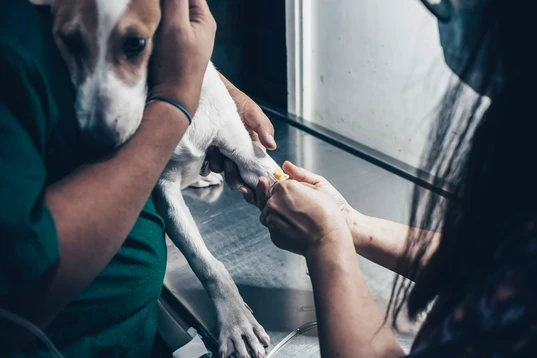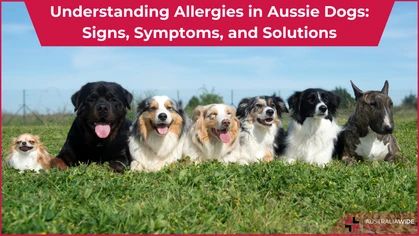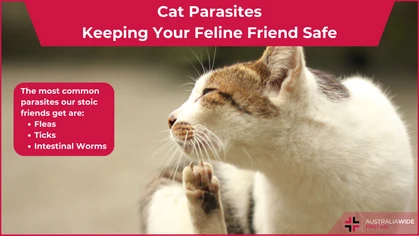Canine Distemper: Causes, Symptoms, Treatment & Prevention

Pets
 Have you ever wondered about the silent fears that linger in the hearts of pet owners? For many dog guardians, canine distemper can send shivers down the spine.
This formidable disease carries a heavy toll, boasting an overall mortality rate of 80% in puppies and 50% in adult dogs.
With the odds stacked against them, owners of infected pups face a challenging and heart-wrenching journey.
In this article, we delve into the details of canine distemper, exploring its causes, symptoms, prevention, and the vital steps every pet owner should take when faced with this challenging disease.
Have you ever wondered about the silent fears that linger in the hearts of pet owners? For many dog guardians, canine distemper can send shivers down the spine.
This formidable disease carries a heavy toll, boasting an overall mortality rate of 80% in puppies and 50% in adult dogs.
With the odds stacked against them, owners of infected pups face a challenging and heart-wrenching journey.
In this article, we delve into the details of canine distemper, exploring its causes, symptoms, prevention, and the vital steps every pet owner should take when faced with this challenging disease.
What Causes Distemper in Dogs?
The paramyxovirus causes the canine distemper, a globally prevalent, highly contagious viral ailment affecting dogs. The virus is detectable in various bodily secretions like urine, blood, saliva, or respiratory droplets of infected animals. Transmission of the virus can transpire through diverse avenues. Dogs can contract the distemper virus via direct interaction with infected animals or their bodily fluids.How Do Dogs Get Distemper?
Dogs contract distemper through exposure to infected dogs or wild animals carrying the paramyxovirus. The distemper in dogs spreads via:- Airborne Droplets: Whenever an infected dog coughs or sneezes, it expels virus-laden droplets into the air. Inhaling these droplets can lead to infection in other dogs.
- Direct Contact: The canine distemper virus can also be transmitted by an infected dog's saliva, urine, or faeces.
- Indirect Contact: The canine distemper virus can survive on surfaces for several days, increasing the likelihood of infection in dogs interacting with contaminated objects like food bowls or toys.
What Are the Canine Distemper Symptoms?
Clinical signs start to manifest around 10-14 days after canine distemper infection. It's crucial to recognize these symptoms early for prompt detection and treatment. While the specific signs may differ from one dog to another, common symptoms include:- Fever
- Respiratory issues such as coughing, sneezing, or difficulty breathing.
- Gastrointestinal disturbances such as vomiting, diarrhea, and loss of appetite.
- Neurological problems including seizures, muscle cramps, and paralysis.
- Ocular discharge and inflammation leading to conjunctivitis.
- Nasal discharge
- Skin sores
- Lethargy
- Depression

Progression of Dog Distemper
Distemper in dogs ultimately leads to spinal cord and brain inflammation, resulting in neurological symptoms in dogs such as head tilting, circling behavior, partial or complete paralysis, muscle twitching, and seizures. As the disease advances, dogs may also develop hyperkeratosis, a condition known as "hard pad." This condition involves the thickening and hardening of the skin, usually the nose and paw pads, which can be uncomfortable. Additionally, dog distemper often weakens the immune system, making dogs susceptible to secondary infections in the lungs and gastrointestinal tract.Diagnostic Tests to Confirm Canine Distemper
When it comes to diagnosing canine distemper, several diagnostic tests are used to confirm the presence of the virus and assess the health status of affected dogs. Let's take a closer look at these tests.- Quantitative PCR Test: Considered the gold standard, this test reliably confirms the virus's genetic material, accurately diagnosing canine distemper and assessing infection in recovered dogs.
- Serology: This test measures blood antibody levels, helping veterinarians determine virus exposure and assess immune response. Elevated antibody levels, alongside a negative PCR test, suggest immunity to further infection.
- Additional Tests: Apart from the mentioned diagnostic tests, your veterinarian may also conduct extra assessments like blood tests or chest X-rays to evaluate overall health and investigate secondary respiratory infections in affected dogs.
How to Treat Distemper in Dogs
Canine distemper treatment is a critical aspect of ensuring your dog's well-being. Early veterinary intervention is paramount if you suspect your dog is unwell. Treatment for canine distemper lacks a definitive cure, but your veterinarian can provide vital supportive care to manage symptoms effectively. Canine distemper cure may involve a combination of interventions such as:- Broad-spectrum antibiotics
- Pain relievers
- Antipyretics to reduce fever
- Anti-inflammatory medications
- Steroids
- Seizure medications
- Electrolytes
- Provision of IV nutrition
- Hospitalization in severe cases
Tips for Treating Dog Distemper at Home
Since canine distemper lacks a cure because it’s a viral disease, providing supportive care and ample affection can enhance your dog's recovery prospects. Here are some guidelines to help you care for your beloved companion during this challenging period.- Comfortable resting space: Create a cozy spot with soft bedding where your dog can relax and feel safe.
- Nutritious diet: Feed your dog high-quality, easily digestible food to support their immune system and aid in recovery.
- Hydration: Ensure your dog has constant access to fresh water to prevent dehydration, a common distemper complication.
- Clean environment: Maintain a hygienic living area for your dog by regularly cleaning and promptly removing waste to prevent secondary infections during their recovery period.
- Regular check-ups: Frequent veterinarian visits are crucial to monitor your dog's progress.
What Are the Canine Distemper Recovery Signs?
When a dog exhibits signs of improvement from distemper, it signals a positive response from their immune system as it combats the virus. Here are some typical distemper recovery signs to observe:- Increased appetite
- Body temperature gradually starts to drop back to normal
- Less coughing and sneezing
- Eyes become clearer
- Reduction in nasal discharge
- Improved GI tract, reducing diarrhoea and vomiting
- Better mood and behaviour
Importance of Vaccination in Preventing Canine Distemper
Curious to know how to prevent distemper in dogs? While there's no direct cure for canine distemper, the key lies in prevention through vaccination, safeguarding our beloved pets from this devastating disease. Distemper vaccines for dogs play a crucial role by triggering the immune system to release antibodies against the distemper virus, offering essential protection. However, the vaccination doesn't ensure absolute immunity from canine distemper. Nevertheless, it significantly lessens the severity of the disease and enhances the chances of recovery. Regular booster shots are vital to maintain the level of protection, as immunity may diminish over time.Canine Distemper Vaccine Schedule
Prevention is the key to addressing canine distemper, and one of the most effective preventive measures is vaccination. Here is a general guideline for the canine distemper vaccine schedule:- Puppies (≤16 Weeks of Age): Puppies should receive a minimum of three doses of a combination vaccine between 6 and 16 weeks. These doses should be given 2-4 weeks apart.
- Dogs (>16 Weeks of Age): Two doses of a combination vaccine are recommended for adult dogs over 16 weeks of age. Each dose should be given 2-4 weeks apart.
- Revaccination and Booster Shots: After the initial vaccination, all dogs should receive a single booster dose within one year following the last dose.
Prognosis of Canine Distemper
The prognosis for dog distemper varies based on the dog's immune response and the infection's severity. While some dogs fully recover and resume a healthy life, others may face ongoing health challenges or succumb to the disease. Remember that if a dog has recovered from distemper, it can still spread the virus for 2 to 3 months. Therefore, it is essential to take precautionary measures when introducing a recovered pet to other dogs or environments where other dogs may be present.Wrapping Up
Vaccination stands as a paramount defence against canine distemper, serving as a shield not only for individual dogs but also as a safeguard for the collective well-being of the canine community. By ensuring our dogs are properly vaccinated, we actively contribute to curbing the disease's transmission and shielding our cherished furry companions from the potentially severe consequences of this illness. It is essential to consult your veterinarian regularly to ensure your furry friends remain up to date with their vaccinations. After all, a vaccinated dog is a happy, healthy, and protected dog!FAQs
How Long Can a Dog Survive With Canine Distemper? Dogs may enter the terminal stage of canine distemper approximately 2 to 4 weeks post-infection, while adult dogs with a more mature immune system can endure the effects for several months. How to Know If a Dog is Recovering from Distemper? Observing positive signs that your dog may be on the road to recovery from distemper includes an improved appetite, elevated energy levels, decreased fever, diminished coughing and sneezing, clearer eyes and nose, and a reduction in diarrhoea and vomiting. If your dog exhibits these improvements, continue watching it closely and follow your vet's advice for good health. When to Put a Dog Down With Distemper? Opting for euthanasia for a dog with distemper is often considered when they enter the advanced stages of the disease, and their pain and quality of life are markedly compromised. Consulting with a professional is recommended since the timing for each case of canine distemper may vary. Is it Possible to Do Canine Distemper Treatment At Home? Dog distemper has no cure. The treatment is usually supportive, geared towards preventing secondary infections, managing diarrhoea and associated neurological symptoms, and ensuring proper hydration by giving fluids. Can a Vaccinated Dog Get Distemper? A dog that has been vaccinated can still get affected by canine distemper virus, but this happens very rarely. The canine distemper vaccine is very good at preventing this illness but is not 100% effective.
Originally published at
https://www.australiawidefirstaid.com.au/resources/canine-distemper
as part of the Australia Wide First Aid Articles Library









